Hacienda tokens from Yucatán (Eusebio Escalente Bates and family)
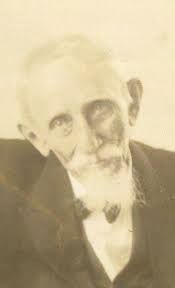
Escalante Bates' father, Eusebio Escalante Castillo, was the main driver of the henequen industry during the 19th century. He believed that the development of the industry needed the right infrastructure , viz. the technological development of the defibration of the henequén; the creation of capital; the demand abroad; the empowerment of the port of Progreso; and the presence of the railway. So from the mid 19th century to the 20th century his family worked from private initiative to ensure that the state met these conditions. Exploiting his relationships with Wall Street bankers, particularly with Thebaud Brothers, Escalante Castillo secured the funding that the henequen ranches required for the production. Its exporting house became the main intermediary in the export of henequén. Over the years, other successful export houses would copy the same scheme that Escalante Castillo had established, becoming important competitors.
In 1884, Eusebio’s father retired from business at the age of 80, and from then on he led the Casa E. Escalante é hijo, then the most important exporting house in the henequen industry.
In 1890, Escalante Bates promoted the foundation of the Banco Mercantil de Yucatán that quickly became one of the most important in the country. Similar to what happened to his export company, the Banco Mercantil de Yucatán received strong competition from the Banco Yucateco, an entity headed by Olegario Molina Solís. In the face of the financial panic of 1907, , both banks were affected to such an extent that they suffered a merger process under the tutelage of the Secretaría de Hacienda, constituting the Banco Peninsular Mexicano.
In 1902, a group of capitalists headed by Escalante Batesamong the investors were well-known Yucatecan entrepreneurs such as Carlos Peón Machado, José Palomeque Solís and Pedro Peón Contreras bought the Mérida-Valladolid railway. This was merged with two other railway companies to found Ferrocarriles Unidos de Yucatán. Although most of the capital had been provided by the Escalante family, the council's presidency was given to his brother-in-law, former governor Peón Machado, while he held the vice presidency of the council and his son, Nicolas Escalante Peón, was general manager.
In partnership with Manuel Dondé Cámara he founded the Merida Tram Company, and with Joaquín A. Peón, Nicanor Ancona Cámara and others, ran a line of steamships.
In partnership with Raymundo Cámara Luján, Agustín Vales Castillo and other minority capitalists, Escalante Bates founded the Agricultural Company of Cuyo y Anexas, S.A. The company had more than 1,500 employees and controlled a 2,627 square kilometres estate in the northwest of Yucatan
The financial panic of 1907 had very serious consequences for the henequen industry in Yucatan, which suddenly saw the orders of its main trading partners in North America slowed down.
Rumors of the collapse of Eusebio Escalante e Hijo had been circulating in Merida throughout the first months of I907. The Escalante house was the oldest casa exportadora in Yucatan, and although it could no longer lay claim to dominance in henequen sales, its investments in the Yucatecan economy were still considerable. Besides the commercial house in Merida, the firm owned the Agencia Comercial, whose warehouses, docks, lighters, and other means of transport enabled the Escalantes to move fiber from hacienda to steamship. The Agencia, which had been created in the late I880s in a partnership with another prominent casa, Manuel Donde y Cia (which succumbed to bankruptcy in an earlier bust cycle in I895), owned considerable real estate in the port of Progreso. In addition, Escalante e Hijo had invested heavily in the Ferrocarriles Unidos, tramway companies, banks, urban properties and haciendas, a variety of attendant service industries and some chancy agricultural companies in the eastern portion of the peninsula. Like all casas, Escalante e Hijo served as creditor to a great number of hacendados: in some cases, it made cash advances; in others, it provided mortgages to planters. Finally, many wealthy busi- nessmen and individuals in Merida and elsewhere had invested in the Escalante casa, including such notable personages as former governor Carlos Pe6n Machado and the wealthy merchant, Pedro Peon Contreras. The Thebaud Brothers, who had first financed the Escalantes in the 1850s and in large measure contributed to the creation of the henequen industry in Yucatan, had running accounts with the casa that exceeded a million dollars. Clearly many stood to lose through association with this economic powerhouse.Gilbert M. Joseph and Allen Wells, “Summer of Discontent: Economic Rivalry among Elite Factions during the Late Porfiriato in Yucatan”. In Journal of Latin American Studies Vol. 18, No. 2 (Nov., 1986), Cambridge University Press.
The Escalante family tried to get the support of the federal government to avoid bankruptcy. However, Olegario Molina's presence in the federal cabinet may have played against him. The fall of the Casa Escalante favored the interests of Molina and his son-in-law and partner, Avelino Montes.
In a desperate but futile effort to avoid bankruptcy, Nicolas Escalante Pe6n went to Mexico City in May and June of 1907 to speak with Ministers Molina and Limantour. What was at stake was more than just the failure of one of the largest henequen firms in the peninsula. Yucatecan banks, especially the Banco Mercantil (the Escalante bank) were also in imminent danger of default. Secretary of Hacienda Limantour agreed to bail out the Yucatecan banks by authorizing the Banco Nacional de Mexico to loan million pesos to the Banco Yucateco and the Banco Mercantil under cetain unspecified conditions. Later in 1908, Limantour would agree to the fusion of the two weakened banks into one stronger institution, the Banco Peninsular Mexicano. While the federal government had intervened prop up the peninsular banking industry during this financial crisis, however, they did not rescue the ailing Escalante casa. Nicolas Escalante Peon and some of his creditors would later suggest that Molina intentionally worked to subvert any type of financial settlement that would save the Escalante house from failure. Although we will probably never know if this is true, the Molinista faction certainly had little interest in propping up Escalante. As a direct result of the Escalante failure in July 1907, Avelino Montes S. en C. would scuttle one of its principal rivals in the henequen trade, obtain control of the Ferrocarriles Unidos de Yucatan and of the peninsular banks, and then use its new clout to purchase a steamship line in I908. Rarely has a business profited so well from another's misfortune. Escalante's demise ensured Molinista dominance over the key facets of the regional economy.Gilbert M. Joseph and Allen Wells, “Summer of Discontent: Economic Rivalry among Elite Factions during the Late Porfiriato in Yucatan”. In Journal of Latin American Studies Vol. 18, No. 2 (Nov., 1986), Cambridge University Press.
When news of the Escalante's bankruptcy became public, financial circles in Mérida, Mexico City, Paris and New York shook. There is ample evidence to suggest that the Escalante's bankruptcy led to a similar bankruptcy of Thebaud Brothers. the New York investment bank. The bankruptcy had repercussions as far away as France, where the Crédit Lyonnais, a bank that had invested significant amounts in the peninsular banks closed its doors in September 1907.
Despite the break of their business empire, the Escalante came out relatively unharmed from the debacle.. Although local judges issued an arrest warrant against Eusebio Escalante Bates and Nicolas Escalante Peón in 1909, a high-ranking "government official" warned the two of their imminent arrest two months before the order was issued. These previous warnings gave them enough time to flee to New York [...] the Escalante received an amparo trial from Mexican courts and were finally exonerated of any crime.
After the bankruptcy of his export home, Escalante Bates retired from business. However, their children, the Peón Escalante, quickly got to work to rebuild the family's commercial empire. He died in 1935.
Hacienda Hotzuc
Hotzuc is located in the municipio of Umán.

Obverse: HOTZUC
Reverse: E. E.
18.8mm. nickel
Hacienda Isincab
Isincab is located in the municipio of Tecoh.
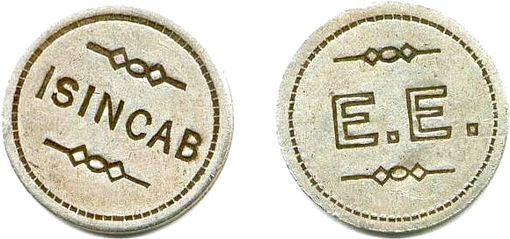
Grove 1685
Obverse: ISINCAB
Reverse: E. E.
18.7mm. nickel
Yokat

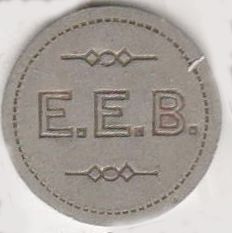
Grove 2018
Obverse: YOKAT
Reverse: E. E. B.
21mm.
The Hacienda Yokat was first founded in the 18th century and for more than 250 years, the hacienda was used in cattle farms, sugar cane production and henequen production. In the 20th century Yokat belonged to the Spanish businessman Avelino Montes, a result, no doubt. of the bankrupcy.
Hacienda Tecoh
Tecoh is located in the municipio of San José Tzal in the department of Mérida. E Escalante G is Eusebio Escalante Galera.
Grove 1620
Obverse: HACIENDA TECOH / E ESCALANTE G
Reverse: ⅛
19mm. white metal
Grove 1621
Obverse: HACIENDA TECOH / E ESCALANTE G
Reverse: ¼
22mm. white metal
Grove 1622
Obverse: HACIENDA TECOH / E ESCALANTE G
Reverse: ½
25mm. white metal
Hacienda San Pedro Nohpat
This hacienda was located inthe municipio of Kanasín.
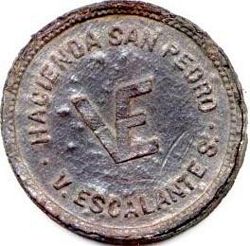
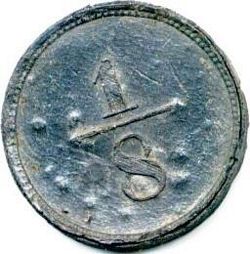
Obverse: HACIENDA SAN PEDRO / moogram VE / V ESCALANTE S.
Reverse: ⅛
22mm. nickel plated
Obverse: HACIENDA SAN PEDRO / moogram VE / V ESCALANTE S.
Reverse: ½
24mm. nickel plated
Calcehtok
Calcehtok is located in the municipio of Opichén.
Obverse: CALCEHTOK
Reverse: E. E. B. (Eusebio Escalente Bates)
19mm. nickel
